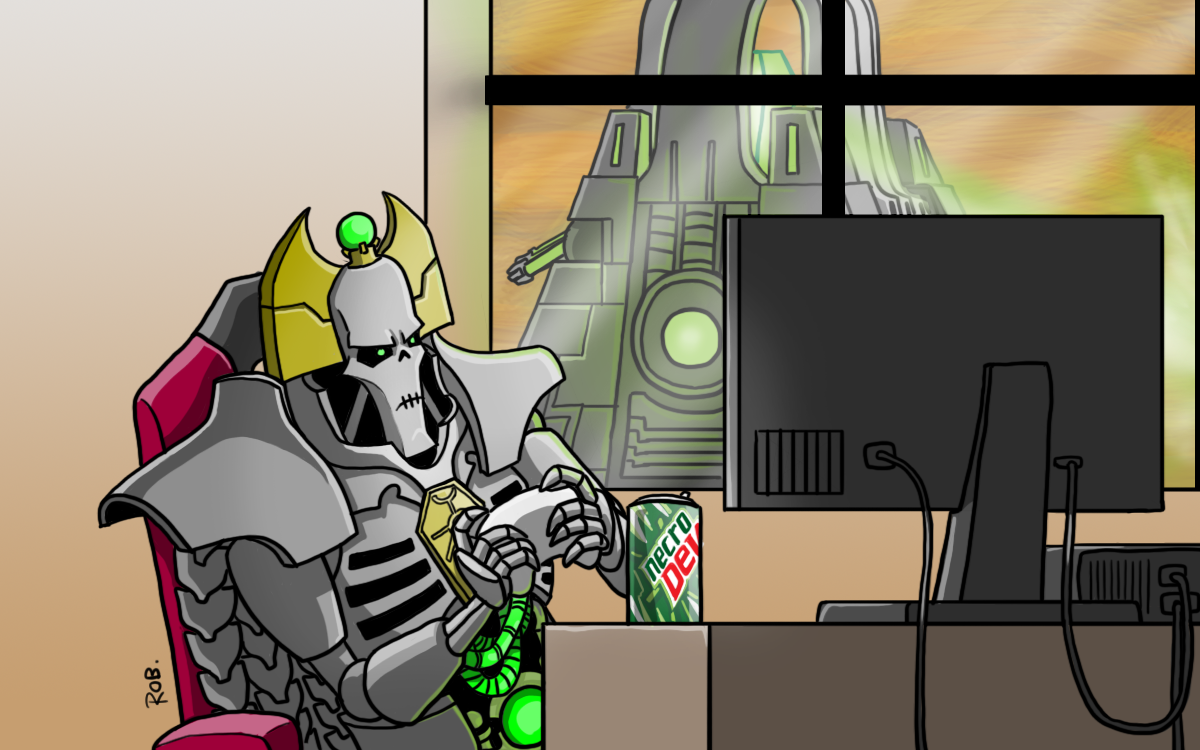Similar to the Imperial forces in Codex: Space Marines (whose Crusade rules we reviewed earlier this week), Necrons got their own set of Crusade rules in their new codex, fleshing out the faction with new agendas, relics, traits, and enhancements. These really flesh the faction out, adding a host of new bespoke abilities and rules for your Necron dynasty/fleet, and they combine very well with the rules laid out in the Beyond the Veil expansion, which also has a bit of a Necron bent (Relics of the Nexus specifically are easy to activate for Necrons).
Today we’ll be diving into the nuts and bolts of these new rules for Necron Crusade forces and offering some thoughts on what works and what doesn’t, and how to handle them in your Crusade.
Agendas
Starting out, the Necrons offer four army-specific Agendas to choose from. As with the Space Marine agendas, these are in a separate category, meaning you’ll typically only be allowed to take one from the Codex. They’re pretty cool, though. The Unending Tally sees your various Destroyers keeping track of the number of units they killed, adding 1 to their tally every time they destroy 2 or more enemy units in a round. They’ll get 2XP for every point on their tally for their trouble.
If you want to demonstrate the Necrons’ incredible power in a more controlled manner, consider Supremacy Through Annihilation. At the start of each round, you’ll choose an enemy unit that’s at its starting strength with no wounded models. If you take that unit from full to dead in the same battle round, every unit that killed at least one model from that unit during that round gains an experience at the end of the game.
Territorial Imperative is a great choice for aspiring Phaerons who want to take the Necrons’ territory back from the meatbags. This is another tally-keeping Agenda, this time with a split objective. First, you add 1 to a unit’s tally every time it destroys an enemy unit that started the turn within 3” of an objective. Second, non-character infantry units can take the Territorial Imperative action if they’re in range of an objective that’s not wholly within your deployment zone, which lasts from the end of your movement phase to your next command phase. If they pull it off, they also get a mark on the tally. This is a pretty cool implementation of a “take and hold” objective, and I’m hopeful that we’ll see more of these sorts of “hybrid” agendas going forward.
Finally, Inescapable Retribution is just really, really cool. The lowly scum on the other side of the table had the unmitigated gall to not only invade your tomb world, but to attempt to make off with your hard-won treasures. To remedy this, you’ll have to take control of an extra objective placed in no-man’s-land with an action, which will grant that unit 3XP at the end of the battle. However, if the unit you send after it is a character, you’ll want to get it back to your deployment zone with its prize. If the battle ends with either that model in your deployment zone or with no enemy units on the board, the character who completed this action gets a free Relic or, if it’s a Cryptek, a free Cryptek Arcana. This bonus reward is extremely cool, and offers a flavorful way to increase the power of your Crusade roster as you win back the spoils taken from you by your enemies.
Condit Note: you could still use the Relic Requisition by spending RP, but I am reliably informed that such an action lies on “The Coward’s Path,” and who wants to go there?
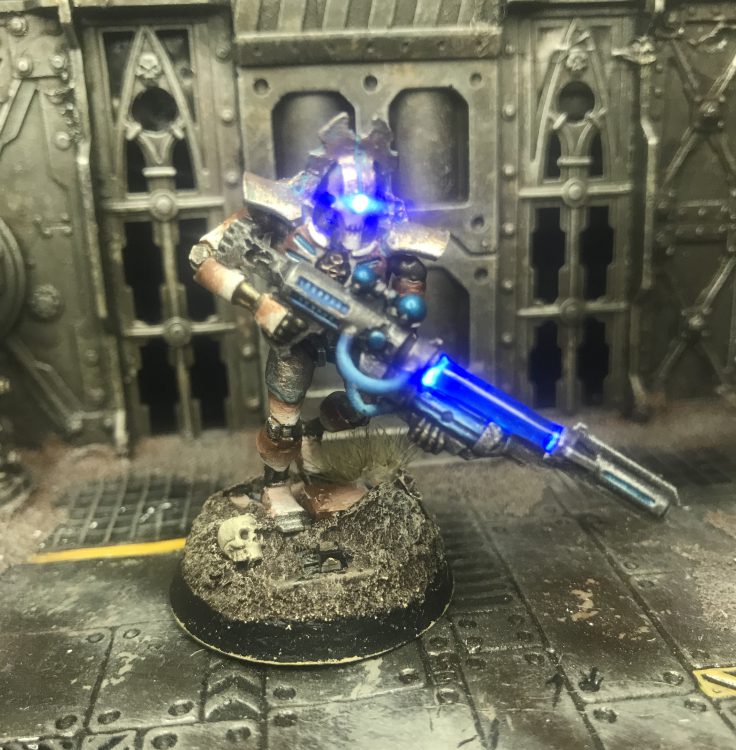
Requisitions
There are 5 new Requisitions here. Three of them, Cryptek Arcana, Cunning Advisors, and Eldritch Artifice, are pretty straightforward upgrades, letting you hand out Arcana to Crypteks, making new Crypteks come into your army with 6XP so long as you’ve got a Noble of Blooded rank or higher, or letting you slap a Weapon Enhancement on a vehicle so long as you’ve got a Technomancer. Neat, but nothing particularly groundbreaking from a narrative perspective.
The other two are really cool, though. First up, The Glory of Subjugation represents the codes of honor that govern wars between rival Necron dynasties: to the winner go the spoils. In addition to bragging rights and a Dynastic Epithet, your Warlord gains 5XP to represent his newfound notoriety, and you can use the Fresh Recruits requisition once for free as your forces bolster their ranks with warriors taken from the enemy’s ranks.
The really cool one here is The Slow Decay of the Self. The lore behind the Destroyer Cults is fascinating, and the way their corrupted thought processes subtly worm their way into other Necrons could give you an incredible narrative hook for your army. If your last game included a Lord or Overlord and any units with the Destroyer Cults keyword, you can remove that Lord or Overlord and replace it with a Destroyer Cult Character from the same dynasty. The new character keeps its XP and gets to pick new Battle Honors as it twists its experience to new, even more omnicidal ends.
This one is doubly cool because, unlike Even in Death I Still Serve for Marines, you can take this after any battle, not just one where you took a battle scar. That means that, rather than being forced to wait for the stars to align, your Overlord can take a heel turn whenever it feels most narratively appropriate.
Battle Traits
Rob: This is where Garrett got so excited about writing about epithets he skipped ahead to that section, leaving me to write about the battle traits. Necrons have 3 battle traits each for Core, Cryptek, Noble, and Canoptek units. C’Tan get nothing, if you were wondering. On the whole, while these aren’t a huge step up from the Core Rules’ battle traits, they are much less likely to leave you with something you can’t really use.
Noble Units
Noble units can extend the range of their My Will Be Done ability, get re-rolls on To Hit rolls of 1, or with the Endless Legion trait, score you an extra RP every time it picks up 3+ XP from a game (not counting Marked for Greatness). These are all pretty decent, and worth looking into as an alternative to rolling on the Character Table in the Core Rules.
Core Units
The Will to Serve will let a unit automatically pass Out of Action tests, Engrammatic Imprinting gives the unit the benefits of a command protocol while any non-C’Tan character is on the table with them, and Undying Revenants gives you a free RP roll of 6 each time you roll, making it a great addition to a 20-man Necron Warrior blob or 10-model Immortals unit. It’s likely even worth taking on Tomb Blades.
Cryptek Units
Crypteks can gain the ability to shoot twice, double up on one of their special abilities (Rites of Reanimation is begging for this), or turn into combat beasts with Dimensional Emancipation, which gives them +1 WS and any attacks that hit automatically wound. Note that in Crusade, Crypteks cannot be upgraded with an item of Cryptek Arkana normally; you must instead use the Cryptek Arcana Requisition to give them one.
Canoptek Units
Finally, the humble Canoptek units get their own set of traits. One of these gives the unit re-rolls on wound rolls of 1 while the unit is within 6” of a Cryptek. Another lets you re-roll Advance and Charge rolls, and Self-Replicator Nodes does the same as Undying Revenants.
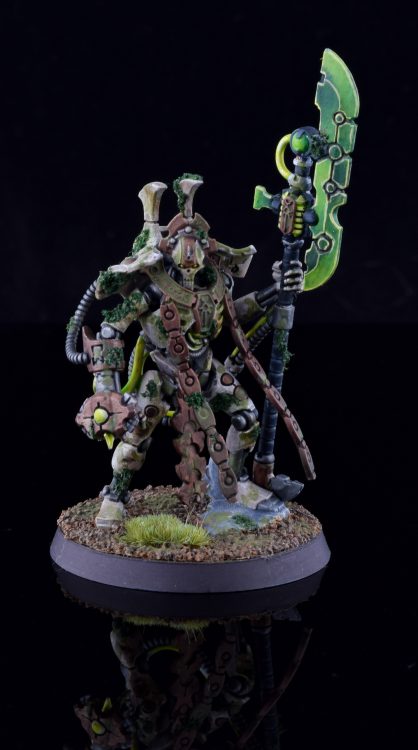
Dynastic Epithets
This section might be the single best set of rules that GW has ever released for 40k. Period. The gist is this: you are presented with a list of 72 “Dynastic Epithets” that could be appended to your Crusade Warlord’s name to appropriately convey his majesty to any disgusting fleshbag he might have the distinct displeasure of being forced to interact with. This table is full of hits, from things as simple as “Monarch of Monarchs” and “King of the Crimson Rising” to more fantastical options such as “Resplendent Master of the Cosmic Fires” and “Dominator of the Pernicious Antedil.” These epithets confer no in-game bonus on their own, but for every three titles you rack up you get to choose a special ability from a list – more on these in a bit.
But you don’t just get to claim these titles. No, you’ve got to earn them. If your Crusade Warlord is a Necron Noble, you are required to generate a new Dynastic Epithet for them every time you win a game. This is not optional. Pretty soon, your Overlord will find themselves having to add to their retinue just so they be properly introduced as Overlord Isketot, Champion of the Ancient Codes, Slayer of a Thousand Foes, Subjugator of the Phloxos Hordes, Majestic Lord of the Shifting Stars, Unrusted Lord of the Bratak Empire, Doom of Morrigar, Oppressor of the Unworthy, Destroyer of the Fleshling Curse, and so on until his robotic attendants somehow run out of breath. Eat your heart out, Settra.
Epithet Bonuses
These titles aren’t purely for show, though: for every three you get, your Noble gains a new ability and increases its Crusade score by one. Some of these are similar to the ones on offer to the Space Marine Masters of the Chapter: a Martial Perfectionist gets the same ability to play a Battle Tactics Stratagem for free once per game as the Master of the Keep, and both the Lord of Legions and the Master of Recruits get to use the Fresh Recruits requisition for 0RP between games.
However, where this section really shines is in the options that don’t resemble any of the Masters of the Chapter. An Arkane Collector hunts down enemies in possession of unique relics and other curios that he has never seen before to add them to his collection, gaining him 2 XP every time he kills an enemy that has a Relic in melee. An Arch-Machinator has been planning and scheming for eons longer than the lesser races have existed, and so gets to choose an additional Agenda before every game, but then has to discard one after both sides reveal their choices. And an Overlord with dreams of being the Restorer of Empires has but one goal – utter domination – which they pursue with single-minded determination, increasing your Crusade force’s Supply Limit by 1 after every battle you win.
Rob: The Dynastic Epithets are by far the coolest set of Crusade rules so far. They add a ton of flavor to your army’s commander and more importantly, give them an incredibly long and cool name.
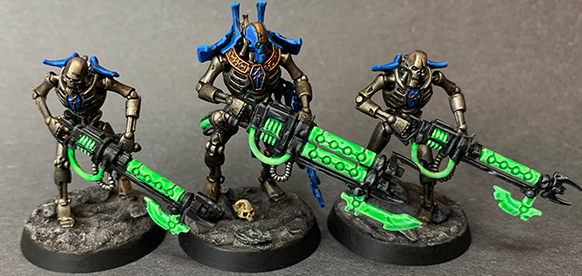
Weapon Enhancements
Instead of taking one of the Weapon Enhancements in the Core Rules, if you’re enhancing a Tesla or Gauss weapon, you can roll on the appropriate table here. There are only 3 options on each, and if your chosen unit is an Infantry or Biker unit, you get to roll twice, re-rolling duplicates. As an added bonus, since there isn’t a sergeant or other “unit champion” in most Necron units, you can upgrade every weapon in the unit, assuming you can rack up enough experience. A squad of Immortals equipped with 2 or 3 enhanced weapons could be particularly nasty and, depending on how far you’re leaning into Cryptek weirdos, potentially right in line with your narrative. This probably isn’t the most efficient use of your experience, but it could be a ton of fun to play with, especially since the small number of choices means you’re that much more likely to get what you wanted anyway.
Tesla Weapons
Electromagnetic Overcapacitors causes your weapon to proc the extra hits on an unmodified 5+ rather than a hard 6. Arcshock Projectors let you use the Malevolent Arcing strat for free if you haven’t already this phase, letting you spread some mortals across your opponent’s army if it’s bunched up. Finally, Atmospheric Fulminator Array gives you +1 to hit and +1 to wound against Aircraft. Of the three, Arcshock Projectors is probably the most useful, since if you’re taking Tesla weapons you’re going to be using Malevolent Arcing anyway, and a trait that effectively reads “Gain 3-5 CP over the course of the game” is extremely worth your while, even on a random Immortal. And if you really want to get nuts (and who doesn’t?), putting any of these on an Annihilation Barge, Night Scythe, or Doom Scythe could be hilarious on their Twin Tesla Destructor’s Heavy 10 stat line.
Gauss Weapons
Three possible upgrades here. Molecular Vaporiser forces units that take a death from it to count as under Half-strength for the rest of the turn. Nanoparticulate Disassembler Coils give you exploding hits on unmodified 6s to hit. And Metallophagic Atomic Decouplers gives you a free use of the Disintegration Capacitors Stratagem once per turn (that’s the Stratagem that makes it so rolls of 6 to hit automatically wound the target). Of these, the Capacitors are probably the best, since you can use it on a small squad of say, Immortals, and use that single model’s shots to score a free use of the Stratagem on another larger unit. Nanoparticulate Disassembler Coils could be interesting on a Ghost Ark, though, where it’s liable to score you 3-4 extra hits every time you get into rapid fire range with it.
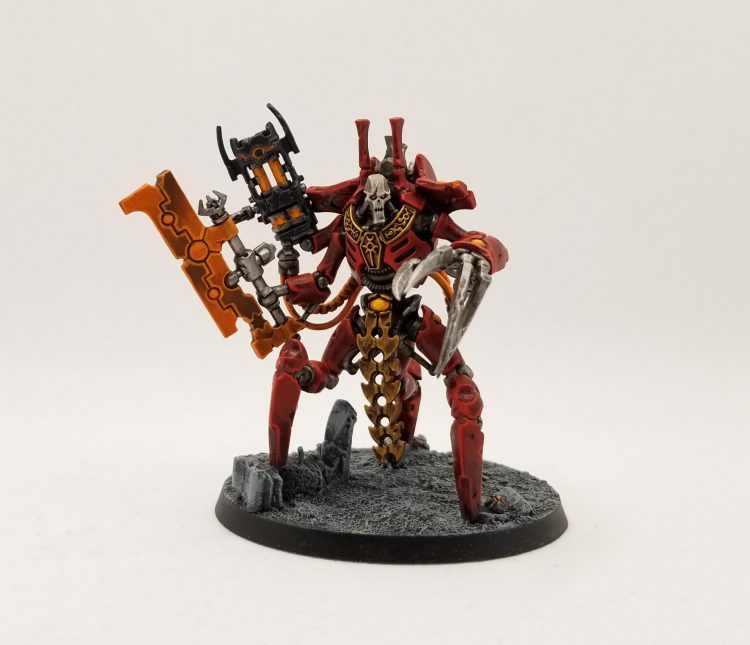
Battle Scars
Codex: Necrons gives Necron players a way to give their units bespoke battle scars based on their unit keywords. And like the excellent Battle Scars presented in Beyond the Veil, these scars have both a positive and a negative impact, giving you more reason to actually take them. Nobles get +1 Strength and +1 Attack but lose My WIll be Done and the ability to give out Command Protocols; a harsh tradeoff and probably not worth losing those abilities.
Destroyer Cult units get to re-roll hits but can only shoot or charge the closest enemy each turn, turning them into the near-uncontrollable berzerkers you expect them to be.
All non-C’Tan Necron units can suffer Engrammatic Degradation, which gives them -1 to their Movement, Advance rolls, and Charge rolls but they always get the benefit of the directive picked in your first battle round, instead of the selected protocol. This means you can mitigate the effect by taking Protocol of the Sudden Storm on turn 1, or keep a unit boosted with something like Protocol of the Vengeful Stars all game. Neat!
Canoptek units can take Depleted Transmetal Reserves, which gives them +1 Attack but takes away their Living Metal and Reanimation Protocols abilities. That’s pretty harsh, and probably not a worthwhile tradeoff.
Overall these are interesting. That they offer at least a semblance of a positive tradeoff makes them immediately desirable over the ones in the Core Rules, which are all downside. They also offer some unique narrative hooks that are much more interesting than the rather bland choices in the Core Rules, many of which don’t make sense for a lot of Necron units anyway – why would it matter to a unit of Warriors if they’d received a Mark of Shame?
Crusade Relics
Necrons also get their own set of four Crusade Relics. The two Artificer Relics are OK – the Transdimensional Shard ensures that wound rolls of 1-3 against the bearer always fail, while the Engrammatic Entagler removes all of a character’s Battle Scars and prevents it from failing Out of Action Tests. Neither is particularly flashy, but they’re solid. At the Antiquity level we get the real fun stuff: The Necroexcrutiator gives the character an Aura that gives C’Tan shards within 12” +1 to their Movement, Strength, Toughness, and Attacks. While the most hilarious use of this is giving a Tesseract Vault T8, it combos extremely well with any of the named C’Tan or the Transcendent variety to give you a S7, T8 monster that can dish out some real pain. Finally, the Tachyon Field Phase Inducer is the Necron Legendary Relic, and it causes mortal wounds each time a melee weapon the bearer has hits an enemy, plus when the bearer is destroyed they explode on a 2+, doing D3 mortals to anything within 3”. This is pretty insane, and exactly the kind of nonsense you want on a Skorpekh Lord who can make a silly number of attacks at WS 2+, re-rolling 1s to hit using the Flensing Claw to double its attacks.
Other Things to Note
Something to note here is that Trazyn’s Ancient Collector ability to give you a free relic in battles gets a supercharging in Crusade, where it reduces the cost of the Relic Requisition to 0 RP, letting you go hog-wild handing out relics to your Crusade force. It’s a higher cost than the Space Marines have to pay for the same ability, but it’s a powerful incentive to add the eccentric collector to your Necron force. I’m suddenly very glad I painted his dumb finecast model.
Final Thoughts
Rob: Overall, the Necrons get some great rules for Crusade, and compared to the new Space Marines Codex, Necrons certainly get the more interesting rule set of the two. There are certainly a few things we’d have liked to have seen more of – more Crusade Relics would have been nice, and I’m of the mind that Crusade relics are a great place to bring back older relic/wargear concepts that haven’t been used in a while, even in updated form. Things like Mindshackle Scarabs or the Nightmare Shroud. They’ve kind of done this with the Necroexcrutiator, which is essentially the God Shackle with a different, less cool name, but it would have been cool to see some more returning gear. Something else I’d have liked to have seen would have been a mechanic for adding new C’Tan shards to your collection and merging several into a Transcendent C’Tan. As it is, unnamed C’Tan don’t interact with Crusade in any real way and that’s kind of a shame. Otherwise, I like these rules a lot. The bonuses are flavorful, the Battle Scars offer at least a semi-interesting trade-off, and the epithets are just incredibly cool.
Condit: I’ve never really had the desire to start a Necron army, but after reading these rules I’m honestly tempted. They’re incredibly cool and honestly blow the Space Marine options out of the water. Even setting aside the fact that you’ll be giving your Warlord a completely rad name that will completely break whatever list-building app you happen to choose, the Battle Traits and Battle Scars on offer will let you create some really interesting units as your campaign progresses. Plus, the new Agendas are cool across the board and really help sell the Necrons as the disdainful ancient horrors they’re supposed to be. The biggest let-down for me is the lack of options to use C’Tan. Not that I really want to run into them on the table, but it would have been cool to see at least some way for them to interact with the Crusade system. On balance, though, I’m excited to see how Necron players build out their Crusade rosters using these options and what stories there are to be told with them.
The hits just keep on coming for Crusade options, and this system remains one of the cooler things about 9th edition. Between the options here and those in Beyond the Veil, Necron players have a wealth of options to build the dynasty they’ve always dreamed of – and that their opponents have always dreaded. If GW can keep this quality up with future releases, things are looking up for narrative play.
Have any questions or feedback? Drop us a note in the comments below or email us at contact@goonhammer.com.
